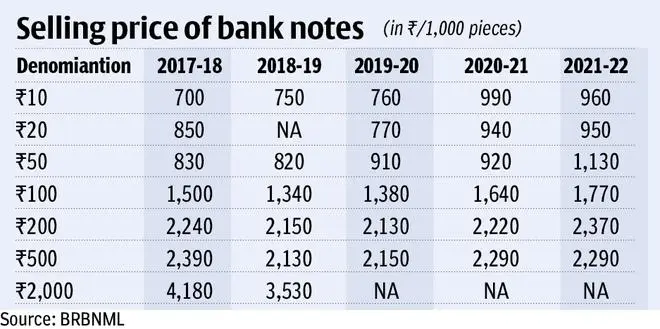Selling price of bank notes in the denomination of ₹20, ₹50, ₹100 and ₹200 has gone up in FY22. However, for notes in the denomination of ₹500, the prices have remained unchanged.

Selling price for 1,000 pieces of ₹50 recorded a maximum increase of around 23 per cent in FY22 over FY21, while that of ₹20 registered the lowest increase of a little over 1 per cent, according to information sourced through RTI from the Bharatiya Reserve Bank Note Mudran Ltd (BRBNML). Although notes of ₹500 denomination are the highest in terms of volume (34.9 per cent of all denomination) among all the paper notes in circulation, and also in terms of value (73.3 per cent of value of all denomination), their selling price has not seen any change in FY22 and FY21.
Through the production
Selling price refers to the price at which printing presses supply paper currency to their sole buyer, the Reserve Bank of India (RBI). There are four presses, of which two are owned by the RBI through its wholly owned subsidiary, BRBNML, while the remaining two come under the ownership of the Central government, operated through its wholly owned company, Security Printing & Minting Corporation of India Limited (SPMCIL). BRBNML presses are situated in Mysuru and Salboni (eastern India). The government-owned presses are at Nasik and Dewas (central India). Coins are minted in four mints owned by the Centre, located in Mumbai, Hyderabad, Calcutta and Noida.
Though, BRBNML did not give any reason for the change in selling prices, it is believed that the prices of most of the denominations went up on account of higher input costs, especially for paper. For ₹500 denomination notes, the no change in prices could be due to economy of scale as 57 per cent of the total indent was for this denomination.
Interestingly, even as RBI spent ₹4,984.8 crore, which is 24 per cent more than it did in FY21 (₹4,012.09 crore), the total supply was lower. The overall cost of printing currency in FY22 was the second highest, after an all-time high of around ₹8,000 crore during the year of demonetisation (2016-17).
Reducing import dependency
According to RBI’s annual report, BRBNML achieved production of 13,350 million pieces of banknotes in FY22. The two-fold increase in direct remittances by BRBNML to currency chests aided the unfettered availability of banknotes during the pandemic.
Colour Shift Intaglio Ink (CSII), a security feature used in Indian banknotes that was imported earlier, is now being indigenously manufactured at Varnika, the ink manufacturing unit at BRBNML, Mysuru, meeting the requirement of both BRBNML and SPMCIL. “This has resulted in significant reduction in import dependency for banknote production as also saving of foreign exchange,” the report said, while adding future course of RBI in terms of currency management will include framing a strategy for complete indigenisation of raw materials for banknote production.




Comments
Comments have to be in English, and in full sentences. They cannot be abusive or personal. Please abide by our community guidelines for posting your comments.
We have migrated to a new commenting platform. If you are already a registered user of TheHindu Businessline and logged in, you may continue to engage with our articles. If you do not have an account please register and login to post comments. Users can access their older comments by logging into their accounts on Vuukle.